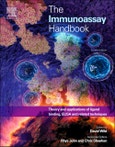The fourth edition of The Immunoassay Handbook provides an excellent, thoroughly updated guide to the science, technology and applications of ELISA and other immunoassays, including a wealth of practical advice. It encompasses a wide range of methods and gives an insight into the latest developments and applications in clinical and veterinary practice and in pharmaceutical and life science research.
Highly illustrated and clearly written, this award-winning reference work provides an excellent guide to this fast-growing field. Revised and extensively updated, with over 30% new material and 77 chapters, it reveals the underlying common principles and simplifies an abundance of innovation.
The Immunoassay Handbook reviews a wide range of topics, now including lateral flow, microsphere multiplex assays, immunohistochemistry, practical ELISA development, assay interferences, pharmaceutical applications, qualitative immunoassays, antibody detection and lab-on-a-chip.
This handbook is a must-read for all who use immunoassay as a tool, including clinicians, clinical and veterinary chemists, biochemists, food technologists, environmental scientists, and students and researchers in medicine, immunology and proteomics. It is an essential reference for the immunoassay industry.
Provides an excellent revised guide to this commercially highly successful technology in diagnostics and research, from consumer home pregnancy kits to AIDS testing. The content is designed to encourage purchases of single chapters or the entire book.
David Wild is a healthcare industry veteran, with experience in biotechnology, pharmaceuticals, medical devices and immunodiagnostics, which remains his passion. He worked for Amersham, Eastman-Kodak, Johnson & Johnson, and Bristol-Myers Squibb, and consulted for diagnostics and biotechnology companies. He led research and development programs, design and construction of chemical and biotechnology plants, and integration of acquired companies. Director-level positions included Research and Development, Design Engineering, Operations and Strategy, for billion dollar businesses. He retired from full-time work in 2012 to focus on his role as Editor of The Immunoassay Handbook, and advises on product development, manufacturing and marketing.
Please Note: This is an On Demand product, delivery may take up to 11 working days after payment has been received.
Table of Contents
Part 1 IMMUNOASSAY FUNDAMENTALS 1.1 How to use this book 1.2 Immunoassays for beginners 1.3 Immunoassay performance measures Part 2 IMMUNOASSAY CONFIGURATIONS 2.1 Competitive and immunometric assays (including ELISA) 2.2 Non-competitive immunoassays for small molecules 2.3 Homogenous immunoassays 2.4 Lateral flow immunoassay devices 2.5 Ambient analyte immunoassay 2.6 Free analyte immunoassay 2.7 Qualitative immunoassays 2.8 Immunoassays for the detection or quantification of antibodies 2.9 Microsphere-based Multiplex Immunoassays: Development and Applications using Luminex xMAP Technology 2.10 Lab on a chip 2.11 Immunological Biosensors 2.12 SPR 2.13 Single Molecule Array Part 3 IMMUNOASSAY COMPONENTS 3.1 Antibodies 3.2 Signal generation systems 3.3 Solid-phase and other separation systems 3.4 Conjugation methods 3.5 Standardisation and calibration 3.6 Calibration curve-fitting Part 4 RELATED TECHNIQUES 4.1 Foundations of immunochemistry 4.2 Immunohistochemistry and immunofluorescence Part 5 IMMUNOASSAY DEVELOPMENT 5.1 Practical guide to ELISA development 5.2 Performance evaluation and validation 5.3 Interferences in immunoassay 5.4 Immunoassay development in industry Part 6 IMMUNOASSAY IMPLEMENTATION 6.1 Subject preparation, sample collection and handling 6.2 Laboratory quality assurance 6.3 Point-of-care testing 6.4 Choosing an automated immunoassay system 6.5 Troubleshooting guide Part 7 IMMUNOASSAY PRODUCT TECHNOLOGY 7.1 Introduction to product technology 7.2 Market trends 7.3 Lateral Flow and Consumer Diagnostics 7.4 Clearblue 7.5 TRIAGE 7.6 Stratus CS 7.7 IMx 7.8 AxSYM 7.9 Architect 7.10 Advia CENTAUR 7.11 IMMULITE and IMMULITE 1000 7.12 IMMULITE 2000 and IMMULITE 2000 Xpi 7.13 Eci 7.14 Vitros Clin chem 7.15 Access 2 7.16 Dxl 600 and 800 7.17 Elecsys 7.18 PRISM 7.19 Phadia systems Part 8 IMMUNOASSAY APPLICATIONS OTHER THAN CLINICAL CHEMISTRY 8.1 Immunoassay applications in veterinary diagnostics 8.2 Immunoassays in the pharmaceutical industry Part 9 IMMUNOASSAY CLINICAL APPLICATIONS (HUMAN) 9.1 Clinical concepts 9.2 Thyroid 9.3 The adrenal cortex 9.4 Bone metabolism 9.5 Infertility 9.6 In vitro fertilization and embryo transfer 9.7 Hirsutism and virilization in the female 9.8 Pregnancy 9.9 Growth and growth hormone deficiency 9.10 Diabetes mellitus 9.11 Hematology 9.12 Cardiac markers 9.13 Cancer markers 9.14 Allergy 9.15 Autoimmune diseases 9.16 GI Tract 9.17 Hepatitis 9.18 HIV 9.19 Other viral diseases (excl HIV and Hepatitis) 9.20 Other bacterial diseases 9.21 Fungal and parasitic diseases 9.22 Therapeutic drug monitoring 9.23 Drugs of abuse








